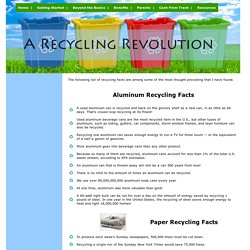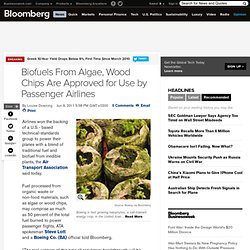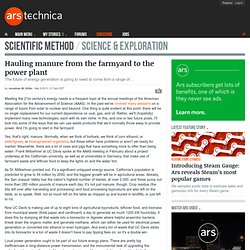

Science. Statistical Data. Space. Easter Island. Located in the Pacific Ocean at 27 degrees south of the equator and some 2200 miles (3600 kilometers) off the coast of Chile, Easter Island is considered to be the world's most remote inhabited island.

Easter Island by Martin Gray One of the world's most famous yet least visited archaeological sites, Easter Island is a small, hilly, now treeless island of volcanic origin. Recycling Facts - A Recycling Revolution. The following list of recycling facts are among some of the most thought provoking that I have found.

These recycling facts have been compiled from various sources including the National Recycling Coalition, the Environmental Protection Agency, and Earth911.org. While I make every effort to provide accurate information, I make no warranty or guarantee that the facts presented here are exact. We welcome all polite corrections to our information. Please also feel free to contact us if you have additional recycling facts to share. Links to our web site are always welcome. For even more information and additional recycling facts, please visitThe National Recycling Coalition. Global Warming / Climate Change. Green Housing. Renewable Energy. CBI calls for end to delays on renewable energy. CBI says business want to get on with low-carbon projects but is hampered by policy uncertainties.

Photograph Mark Mitchell/Reuters Business leaders are to accuse ministers of failing to lay the groundwork fast enough for the raft of urgently needed low-carbon energy projects that are vital if Britain is to plug the widening gap between its energy requirements and its fast dwindling sources of power. China's super-rich: Zhu Gongshan. 5 July 2011Last updated at 19:00 ET By Nick Rosen Author and film-maker Zhu Gongshan's company GCL-Poly is now China's largest producer of polysilicon, the main material in solar panels There is little information in the public domain about energy company boss Zhu Gongshan - and one gets the impression he prefers it that way.

While other billionaires invited me to their offices or even their homes, Zhu preferred to talk in a hotel suite hired solely for the occasion. Zhu, 53, is one of the Party Traditionalists, and is not secretive so much as modest - a trait much prized among a certain type of successful businessman in China today. His company GCL-Poly is now China's largest producer of polysilicon, the main material in solar panels, yet despite his $2 billion (£1.24 billion) fortune Zhu seemed uninterested in the luxury brands which motivate so many of the newly-successful Chinese. The watch he was wearing was a humble Citizen. Biofuels From Algae, Wood Chips Are Approved for Use by Passenger Airlines.
Airlines won the backing of a U.S.- based technical-standards group to power their planes with a blend of traditional fuel and biofuel from inedible plants, the Air Transport Association said today.

Fuel processed from organic waste or non-food materials, such as algae or wood chips, may comprise as much as 50 percent of the total fuel burned to power passenger flights, ATA spokesman Steve Lott and a Boeing Co. (BA) official told Bloomberg. “The real winners of this type of regulatory breakthrough will be technology companies involved in the production of aviation biofuels,” said Harry Boyle, an analyst at Bloomberg New Energy Finance in London. GREEN DEALS: Airlines approve algae fuel. Hauling manure from the farmyard to the power plant.
Meeting the 21st century's energy needs is a frequent topic at the annual meetings of the American Association for the Advancement of Science (AAAS).

In the past we've covered many sessions on a range of topics from solar to nuclear and beyond. One thing is quite evident at this point: there will be no single replacement for our current dependence on coal, gas, and oil. Rather, we'll (hopefully) implement many new technologies, each with its own niche. In this, and one or two future posts, I'll look into some of the ways that we can use waste products that we'd normally throw away to provide power. And I'm going to start in the farmyard. Yes, that's right, manure. As Dr. Now UC Davis is making use of up to eight tons of agricultural byproducts, leftover food, and biomass from municipal waste (think paper and cardboard) a day to generate as much 1200 kW hours/day. Using waste heat to fill the bath: desalination in Abu Dhabi. Last week, we covered one of the talks from a great session on using waste as a resource that took place at the annual meeting of the American Association of the Advancement of Science (AAAS).

That one was about using farmyard byproducts to generate biogas, but it wasn't the only example of increasing energy efficiency through capturing waste. David Scott gave a presentation on how Abu Dhabi is meeting its fresh water needs using waste heat from power generation, and it's a strategy that might come in handy here in the US in the not-too-distant future. One of the Gulf states, Abu Dhabi has lots of natural gas and plenty of spare heat, with some of the hottest temperatures recorded on our planet during their summer. As a result, the thermal efficiency of its gas turbine plants, even when run on a combined cycle (where waste heat powers a secondary steam generator) is only about 41 percent, compared to up to 60 percent in more temperate climates.
So far, not so good.